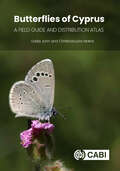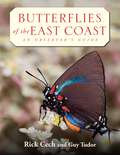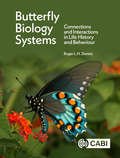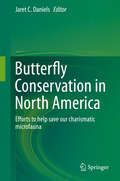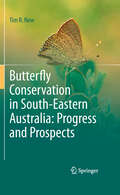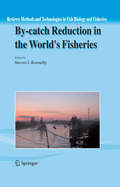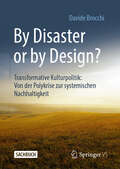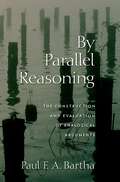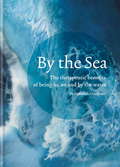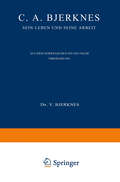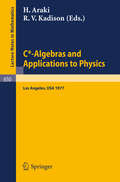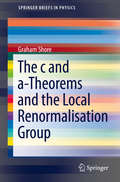- Table View
- List View
Butterflies of Cyprus: A Field Guide and Distribution Atlas
by Eddie John Christodoulos MakrisThis new book summarises decades of research and collation of distributional data. From the tiny Freyeria trochylus (Grass Jewel), Europe's smallest butterfly, to the magnificent, newly arrived Papilio demoleus (Lime Swallowtail), this comprehensively illustrated reference book and field guide includes all butterfly species known in Cyprus over the past 100 years. Where applicable, reference is made to subspecies of related taxa present in nearby countries of the eastern Mediterranean. The images on the cover represent the island's seven endemics, discussed in depth. Included, too, are detailed distribution maps representing records garnered from almost 300 recorders/sources (particularly members of the Cyprus Butterfly Study Group), over a period of more than 20 years.
Butterflies of the East Coast: An Observer's Guide
by Rick Cech Guy TudorHere is an accessible, informative, and highly illustrated book that offers a fresh view of butterflies in the East Coast states, from the Atlantic seaboard to the Appalachians. In addition to providing a wealth of facts and photos, the book is the first to furnish detailed and up-to-date photo-illustrated information on the host plants favored by particular species. With 234 full-page species accounts and accompanying range maps, plus more than 950 large-size color photos, it is an essential reference work for field observers, gardeners, educators, and conservation managers--or anyone interested in appreciating the lepidopteran world close at hand.The introductory chapters detail the subtle ecology of the East Coast region, establishing a consistent ecological framework that enriches the individual species accounts. There is also an overview of current scientific literature and observational findings to help readers better interpret complex butterfly behaviors in the field, including seasonal movements, host plant and diapause strategies, defensive chemistry, and more.The book is written by Rick Cech, a seasoned field observer who has spent years studying and photographing East Coast butterflies. His substantial first-hand experience with both the common and rare species in the region adds much depth and new insight to the commentary.234 full-page species accounts and accompanying range maps950 large-size color photos215 photos of individual host plants and habitats735 high-quality photos of butterflies and caterpillarsIntroductory chapters detailing the subtle ecology of the East Coast regionAn overview of current scientific literature and observational findingsDescriptions of diapause and host plant strategies and defensive chemistryUser-friendly with clear, concise text
Butterfly Biology Systems: Connections and Interactions in Life History and Behaviour
by Roger L DennisIn Butterfly Biology Systems Roger Dennis explores key topics and contentious issues in butterfly biology, specifically those in life history and behaviour. Uniquely, using a systems approach, the book focuses on the degree of integration and feedback between components and elements affecting each issue, as well as the links between different issues. The book comprises four sections. The first two sections introduce the reader to principles and approaches for investigating complex relationships, and provide a platform of knowledge on butterfly biology. The final two sections deal in turn with life history and behaviour, covering key issues affecting different stages of development from eggs to adults. The book is extensively illustrated with original diagrams and models, all of which have detailed legends, produced to enhance a broader understanding, and to provide templates for future research. It includes a detailed bibliography and glossary providing an essential gateway to the extensive literature on butterfly biology. Butterfly Biology Systems is essential reading for graduate students and researchers in insect ecology, evolution, behaviour and conservation. It will also be of great value to anyone interested in butterflies. Introduces a systems approach to butterfly biology Includes succinct reviews of the key interrelationships in butterfly life history and behaviour Illustrates more than 100 models to advance research into butterfly biology systems
Butterfly Conservation in North America: Efforts to help save our charismatic microfauna
by Jaret C. DanielsThe book addresses this critical need by providing a straightforward and easy to read primer to key elements of at-risk butterfly conservation programs including captive husbandry, organism reintroduction, habitat restoration, population monitoring, recovery planning and cooperative programs.Impacts from habitat loss and fragmentation, invasive species, and climate change continue to accelerate the rate of imperilment and necessitate increased conservation action.Zoos, natural history museums, botanical gardens and wildlife agencies are progressively focusing on insects, particularly charismatic groups such as butterflies and native pollinators, to help advance local conservation efforts and foster increased community interest and engagement.Today, many institutions and their partners have successfully initiated at-risk butterfly conservation programs, and numerous others are exploring ways to become involved. However, insufficient experience and familiarity with insects is a critical constraint preventing staff and institutions from adequately planning, implementing and evaluating organism-targeted activities.The information provided is intended to improve staff practices, learn from existing programs, promote broader information exchange, and strengthen institutional ability to develop new or improve existing butterfly conservation initiatives.The information provided is intended to improve staff practices, learn from existing programs, promote broader information exchange, and strengthen institutional ability to develop new or improve existing butterfly conservation initiatives.This book will be useful to professionals from zoos, natural history museums, botanical gardens, wildlife agencies, conservation organizations, land managers, students, and scientist in conservation biology, ecology, entomology, biology, and zoology.
Butterfly Conservation in South-Eastern Australia: Progress and Prospects
by Tim R. NewA survey of the development and practice of butterfly conservation in south east Australia, tracing evolution of the science through a series of cases from focus on single subspecies through increasing levels of ecological complexity to critical biotopes and communities. The book summarises much previously scattered information, and provides access to much regional information of considerable interest to practitioners elsewhere.
A Butterfly is Born
by Melvyn BergerFollow a butterfly from its birth to its evolution into a butterfly.
A Butterfly is Born (PDF)
by Melvyn BergerFollow a butterfly from its birth to its evolution into a butterfly.
The butterflyfishes: success on the coral reef (Developments in Environmental Biology of Fishes #9)
by Philip J. MottaButterflyfishes of the family Chaetodontidae are conspicuous members of almost all tropical reefs. These colorful fishes have attracted a great deal of attention from both the scientific community and especially the aquarium fish industry. At first one is tempted to say that butterflyfishes are abundant worldwide, but the evidence does not support this statement. The biomass of chaetodontids on reefs may range from 0.02-0.80%, and in terms of numbers they comprise only 0.04-0.61 % of the individuals on the reef. Yet in spite of these relatively small numbers they have been extensively studied. A quick census shows some 170 articles on or about butterfly fishes, with 78% of them being published since the 1970's. Along with the cichlids and damselfishes they might be one of the most studied and well published family of tropical fishes. Why then have chaetodontids attracted so much attention? The butterflyfishes are mostly shallow water inhabitants that are approachable and easily recognizable, making their study very feasible. Their bright coloration has provoked many hypotheses but has posed more questions about coloration than it has provided answers. And despite their apparent overall morphological similarity, their highly structured and varied social systems have made them an ideal model for such studies. The reasons for choosing these organisms are indeed as diverse as the studies themselves.
Buttress’s World Guide to Abbreviations of Organizations
by Jean C. SwinbankThis edition of over 60 000 entries, including significantly more than 20% new or revised material, not only updates its predecessor but also continues the policy of extending coverage to areas dealt with only sparsely in previous editions. Special attention has been paid to the Far East, Australasia and Latin America in general, and to the People's Republic of China in particular. The cross-referencing between a defunct organization and its successor (indicated by ex and now) introduced into the last edition, has been extended. Otherwise the policies adopted in previous editions have been retained. All kinds of organizations are included - international, national, governmental, individual, large or small - but strictly local organizations have been omitted. The subject scope includes activities of all kinds, in the fields of commerce and industry, education, law, politics, public administration, religion, recreation, medicine, science and technology. The country of origin of a national organization is given in brackets, unless it is the home country of the title language or can be deduced readily from the title itself. Acronyms of parent bodies of subsidiary organizations are also added in brackets. Equivalences are used to link acronyms in different languages for the same organization. A select bibliography guides the reader to specialist works providing more detailed information.
A Buyer's and User's Guide to Astronomical Telescopes and Binoculars (The Patrick Moore Practical Astronomy Series)
by James MullaneyAmateur astronomers of all skill levels are always contemplating their next telescope, and this book points the way to the most suitable instruments. Similarly, those who are buying their first telescopes – and these days not necessarily a low-cost one – will be able to compare and contrast different types and manufacturers. This exciting and revised new guide provides an extensive overview of binoculars and telescopes. It includes detailed up-to-date information on sources, selection and use of virtually every major type, brand, and model on today’s market, a truly invaluable treasure-trove of information and helpful advice for all amateur astronomers. Originally written in 2006, much of the first edition is inevitably now out of date, as equipment advances and manufacturers come and go. This second edition not only updates all the existing sections of “A Buyer’s and User’s Guide to Astronomical Telescopes and Binoculars” but adds two new ones: Astro-imaging and Professional-Amateur collaboration. Thanks to the rapid and amazing developments that have been made in digital cameras – not those specialist cool-chip astronomical cameras, not even DSLRs, but regular general-purpose vacation cameras – it is easily possible to image all sorts of astronomical objects and fields. Technical developments, including the Internet, have also made it possible for amateur astronomers to make a real contribution to science by working with professionals. Selecting the right device for a variety of purposes can be an overwhelming task in a market crowded with observing options, but this comprehensive guide clarifies the process. Anyone planning to purchase binoculars or telescopes for astronomy – whether as a first instrument or as an upgrade to the next level – will find this book a treasure-trove of information and advice. It also supplies the reader with many useful hints and tips on using astronomical telescopes or binoculars to get the best possible results from your purchase.
A Buyer's and User's Guide to Astronomical Telescopes & Binoculars (The Patrick Moore Practical Astronomy Series)
by James MullaneyBoth beginning/novice amateur astronomers (at the level of Astronomy and Night Sky magazine readers), as well as more advanced amateur astronomers (level of Sky and Telescope) will find this book invaluable and fascinating. It includes detailed up-to-date information on sources, selection and use of virtually every major type, brand and model of such instruments on today’s market. The book also includes details on the latest released telescope lines, e.g. the 10-, 12-, 14- and 16-inch aperture models of the Meade LX-R series. As a former editor for Sky & Telescope, Astronomy, and Star & Sky magazines, the author is the ideal person to write this book.
Buying and Selling Laboratory Instruments: A Practical Consulting Guide
by Marvin C. McMasterA time-tested, systematic approach to the buying and selling of complex research instruments Searching for the best laboratory instruments and systems can be a daunting and expensive task. A poorly selected instrument can dramatically affect results produced and indirectly affect research papers, the quality of student training, and an investigator's chances for advancement. Buying and Selling Laboratory Instruments offers the valuable insights of an analytical chemist and consultant with over four decades of experience in locating instruments based upon both need and price. It helps all decision makers find the best equipment, service, and support while avoiding the brand-loyalty bias of sales representatives so you can fully meet your laboratory's requirements. The first section of the book guides buyers through the hurdles of funding, purchasing, and acquiring best-fit instruments at the least-expensive price. It explains how to find vendors that support their customers with both knowledgeable service and application support. Also offered is guidance on adapting your existing instruments to new applications, integrating new equipment, and what to do with instruments that can no longer serve in research mode. The second section explains the sales process in detail. This is provided both as a warning against manipulative sales reps and as a guide to making the sale a win-win process for you and your vendor. It also shows you how to select a knowledgeable technical guru to help determine the exact system configuration you need and where to find the best price for it. Added bonuses are summary figures of buying sequence and sales tools and an appendix containing frequently asked questions and memory aids. Buying and Selling Laboratory Instruments is for people directly involved in selecting and buying instruments for operational laboratories, from the principle investigator to the person actually delegated with investigating and selecting the system to be acquired. Sales representatives; laboratory managers; universities; pharmaceutical, biotech, and forensic research firms; corporate laboratories; graduate and postdoctoral students; and principle investigators will not want to be without this indispensible guide.
Buying and Selling Laboratory Instruments: A Practical Consulting Guide
by Marvin C. McMasterA time-tested, systematic approach to the buying and selling of complex research instruments Searching for the best laboratory instruments and systems can be a daunting and expensive task. A poorly selected instrument can dramatically affect results produced and indirectly affect research papers, the quality of student training, and an investigator's chances for advancement. Buying and Selling Laboratory Instruments offers the valuable insights of an analytical chemist and consultant with over four decades of experience in locating instruments based upon both need and price. It helps all decision makers find the best equipment, service, and support while avoiding the brand-loyalty bias of sales representatives so you can fully meet your laboratory's requirements. The first section of the book guides buyers through the hurdles of funding, purchasing, and acquiring best-fit instruments at the least-expensive price. It explains how to find vendors that support their customers with both knowledgeable service and application support. Also offered is guidance on adapting your existing instruments to new applications, integrating new equipment, and what to do with instruments that can no longer serve in research mode. The second section explains the sales process in detail. This is provided both as a warning against manipulative sales reps and as a guide to making the sale a win-win process for you and your vendor. It also shows you how to select a knowledgeable technical guru to help determine the exact system configuration you need and where to find the best price for it. Added bonuses are summary figures of buying sequence and sales tools and an appendix containing frequently asked questions and memory aids. Buying and Selling Laboratory Instruments is for people directly involved in selecting and buying instruments for operational laboratories, from the principle investigator to the person actually delegated with investigating and selecting the system to be acquired. Sales representatives; laboratory managers; universities; pharmaceutical, biotech, and forensic research firms; corporate laboratories; graduate and postdoctoral students; and principle investigators will not want to be without this indispensible guide.
The Buzz about Bees: Biology of a Superorganism
by Jürgen TautzTis book, already translated into ten languages, may at frst sight appear to be just about honeybees and their biology. It c- tains, however, a number of deeper messages related to some of the most basic and important principles of modern biology. Te bees are merely the actors that take us into the realm of phys- ology, genetics, reproduction, biophysics and learning, and that introduce us to the principles of natural selection underlying the evolution of simple to complex life forms. Te book destroys the cute notion of bees as anthropomorphic icons of busy self-sacr -i fcing individuals and presents us with the reality of the colony as an integrated and independent being—a “superorganism”—with its own, almost eerie, emergent group intelligence. We are s- prised to learn that no single bee, from queen through drone to sterile worker, has the oversight or control over the colony. - stead, through a network of integrated control systems and fee- backs, and communication between individuals, the colony - rives at consensus decisions from the bottom up through a type of “swarm intelligence”. Indeed, there are remarkable parallels between the functional organization of a swarming honeybee colony and vertebrate brains.
By-catch Reduction in the World's Fisheries (Reviews: Methods and Technologies in Fish Biology and Fisheries #7)
by Steven J. KennellyWith by-catch in fisheries becoming an ever more high-profile problem, this brilliant work could not be more timely. It contains contributions from the world’s leading experts in by-catch reduction, who guide the reader through most aspects of the field. They examine the methodologies used to develop by-catch reduction techniques and provide new avenues for broadening such work. Case studies are provided that encompass most of the world’s fishing techniques and regions.
By Disaster or by Design?: Transformative Kulturpolitik: Von der Polykrise zur systemischen Nachhaltigkeit
by Davide BrocchiJede große Transformation in der Geschichte der Menschheit wurde bisher von einer kulturellen Revolution ausgelöst und begleitet. Diese Publikation zeigt, warum dies auch für die Transformation zur Nachhaltigkeit gilt. Im Fokus stehen nicht nur Werte, Menschen- und Naturbilder, sondern auch die gesellschaftliche Verantwortung von Bildung, Wissenschaft, Kunst und Medien. Für die zweite Auflage wurden die Inhalte überarbeitet und aktualisiert, Thesen geschärft und neue Studien einbezogen.Gegenwärtig befinden wir uns zwischen zwei großen gesellschaftlichen Transformationen: Die erste ist die kapitalistisch-industrielle, die vor fünf Jahrhunderten begann, bis heute dominiert und sich am Kulturprogramm der Modernisierung orientiert. Sie hat die Gesellschaft in eine Polykrise geführt, es droht ein Zivilisationskollaps. Die zweite Transformation ist jene zur Nachhaltigkeit, die sich an „Visionen einer anderen Entwicklung“ jenseits von Wachstum und Massenkonsum orientiert. Diese beiden Transformationen verdrängen sich an einigen Stellen gegenseitig und vermischen sich an anderen. Einerseits ist es die schwächere Transformation, die oft assimiliert wird. So werden derzeit eine „ökologische Modernisierung“ und ein „nachhaltiges Wachstum“ theorisiert, obwohl solche Ansätze Widersprüche an sich sind. Andererseits ist die soziale und ökologische Umwelt ein politisches Subjekt, das immer stärker in Dynamiken und Debatten mitmischt. So oder so wird sich an den Reibungsflächen zwischen den beiden Transformationen entscheiden, wie sich die Transformation zur Nachhaltigkeit am Ende durchsetzt: by Disaster or by Design.
By Parallel Reasoning
by Paul BarthaIn By Parallel Reasoning Paul Bartha proposes a normative theory of analogical arguments and raises questions and proposes answers regarding (i.) criteria for evaluating analogical arguments, (ii.) the philosophical justification for analogical reasoning, and (iii.) the place of scientific analogies in the context of theoretical confirmation.
By the Sea: The therapeutic benefits of being in, on and by the water
by Dr Deborah CracknellIn this stunning book, intuition and instinct meet modern science as the therapeutic benefits of being in, on or by the sea are explained and explored, and how, if we look after the oceans they will, in turn, look after us. There is something about the vastness of the oceans, which are significantly larger than the continents combined, that has drawn humans in a significant way since the beginning of coastal communities. Throughout history, people have gravitated to live near the sea, it is part of the survival instinct. Water also has huge cultural and spiritual significance for people through the ages and for centuries we looked to the sand and surf as a fully-stocked medicine cabinet. Despite the widespread intuitive feeling that being by the water makes us happier and healthier, there hasn't been much scientific evidence to quantify this connection. Until now. Environmental psychology is the study of how the natural environment makes us feel, think and behave, and scientists in this area are discovering the tangible benefits of breathing in the fresh sea air.Reasons to spend time by the sea:1. Just looking at the sea can promote reductions in heart rate and improvements in mood.2. The negative ions in sea air accelerate your ability to absorb oxygen, and balance your seratonin levels.3. The bracing climate is especially beneficial to the respiratory organs and the skin, and also improves circulation and strengthens the body's defences.4. Spending time by the sea promotes better mental health.5. When you are by the sea you are more likely to exercise.
C. A. Bjerknes: Sein Leben und seine Arbeit
by Else BjerknesDieser Buchtitel ist Teil des Digitalisierungsprojekts Springer Book Archives mit Publikationen, die seit den Anfängen des Verlags von 1842 erschienen sind. Der Verlag stellt mit diesem Archiv Quellen für die historische wie auch die disziplingeschichtliche Forschung zur Verfügung, die jeweils im historischen Kontext betrachtet werden müssen. Dieser Titel erschien in der Zeit vor 1945 und wird daher in seiner zeittypischen politisch-ideologischen Ausrichtung vom Verlag nicht beworben.
C*-Algebras and Applications to Physics: Proceedings, Second Japan-USA Seminar, Los Angeles, April 18-22, 1977 (Lecture Notes in Mathematics #650)
by H. Araki R. V. KadisonC*-Algebras and Mathematical Foundations of Quantum Statistical Mechanics: An Introduction (Latin American Mathematics Series)
by Jean-Bernard Bru Walter Alberto de Siqueira PedraThis textbook provides a comprehensive introduction to the mathematical foundations of quantum statistical physics. It presents a conceptually profound yet technically accessible path to the C*-algebraic approach to quantum statistical mechanics, demonstrating how key aspects of thermodynamic equilibrium can be derived as simple corollaries of classical results in convex analysis. Using C*-algebras as examples of ordered vector spaces, this book makes various aspects of C*-algebras and their applications to the mathematical foundations of quantum theory much clearer from both mathematical and physical perspectives. It begins with the simple case of Gibbs states on matrix algebras and gradually progresses to a more general setting that considers the thermodynamic equilibrium of infinitely extended quantum systems. The book also illustrates how first-order phase transitions and spontaneous symmetry breaking can occur, in contrast to the finite-dimensional situation. One of the unique features of this book is its thorough and clear treatment of the theory of equilibrium states of quantum mean-field models. This work is self-contained and requires only a modest background in analysis, topology, and functional analysis from the reader. It is suitable for both mathematicians and physicists with a specific interest in quantum statistical physics.
The c and a-Theorems and the Local Renormalisation Group (SpringerBriefs in Physics)
by Graham ShoreThe Zamolodchikov c-theorem has led to important new insights in the understanding of the Renormalisation Group (RG) and the geometry of the space of QFTs. The present primer introduces and reviews the parallel developments of the search for a higher-dimensional generalisation of the c-theorem and of the Local RG (LRG).The idea of renormalisation with position-dependent couplings, running under local Weyl scaling, is traced from its early realisations to the elegant modern formalism of the LRG. The key rôle of the associated Weyl consistency conditions in establishing RG flow equations for the coefficients of the trace anomaly in curved spacetime, and their relation to the c-theorem and four-dimensional a-theorem, is explained in detail.A number of different derivations of the c-theorem in two dimensions are presented and subsequently generalised to four dimensions. The obstructions to establishing monotonic C-functions related to the trace anomaly coefficients in four dimensions are explained. The possibility of deriving an a-theorem for the coefficient of the Euler-Gauss-Bonnet density is explored, initially by formulating the QFT on maximally symmetric spaces. Then the formulation of the weak a-theorem using a dispersion relation for four-point functions is presented. Finally, the application of the LRG to the issue of limit cycles in theories with a global symmetry is described, shedding new light on the geometry of the space of couplings in QFT.
C-C Bond Activation (Topics in Current Chemistry #346)
by Guangbin DongThe series Topics in Current Chemistry presents critical reviews of the present and future trends in modern chemical research. The scope of coverage is all areas of chemical science including the interfaces with related disciplines such as biology, medicine and materials science. The goal of each thematic volume is to give the non-specialist reader, whether in academia or industry, a comprehensive insight into an area where new research is emerging which is of interest to a larger scientific audience. Each review within the volume critically surveys one aspect of that topic and places it within the context of the volume as a whole. The most significant developments of the last 5 to 10 years are presented using selected examples to illustrate the principles discussed. The coverage is not intended to be an exhaustive summary of the field or include large quantities of data, but should rather be conceptual, concentrating on the methodological thinking that will allow the non-specialist reader to understand the information presented. Contributions also offer an outlook on potential future developments in the field. Review articles for the individual volumes are invited by the volume editors. Readership: research chemists at universities or in industry, graduate students
C-C Cross Couplings with 3d Base Metal Catalysts (Topics in Organometallic Chemistry #71)
by Xiao-Feng WuThis volume presents recent progress on 3d base metal catalyzed C-C cross coupling reactions. The contributions provide detailed discussions on the use of cheap metal catalysts such as Cr, Mn, Fe, Co, Ni, Cu, and Zn to construct Csp2-Csp2, Csp2-Csp3 and Csp3-Csp3 bonds with a variety of substrates. These non-noble metal catalyst have many advantages such as being inexpensive, having low toxicity and are environmentally benign. Therefore the use of cheap metal catalysts in organic synthesis has gained much attention in efforts to develop more sustainable synthetic green chemistry. Each chapter is written by international experts in the field and is a great resource for students, researchers and chemists working in industry to gain an overview on the latest developments.
c-di-GMP Signaling: Methods and Protocols (Methods in Molecular Biology #1657)
by Karin SauerThis volume provides a collection of protocols for the common experimental approaches used in the in the burgeoning field of c-di-GMP-dependent signaling. The chapters, divided into eight major parts, guide readers through methods on synthesis, detection, quantitation, modulation of the levels of c-di-GMP present in cells, procedures to detect and evaluate the interaction of c-di-GMP, and up and coming approaches focusing on the inhibition of c-di-GMP signaling.Written in the highly successful Methods in Molecular Biology series format, chapters include introductions to their respective topics, lists of the necessary materials and reagents, step-by-step, readily reproducible laboratory protocols, and tips on troubleshooting and avoiding known pitfalls. Authoritative and cutting-edge, c-di-GMP Signaling: Methods and Protocols aims to inspire researchers to try new approaches.
